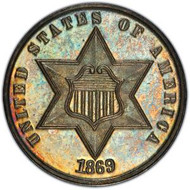Silver Three Cent Coins: The Lightest American Money
Posted by Bullion Shark on Apr 8th 2022
Silver Three Cent Coins
Following the California Gold Rush of 1848, the ratio between gold and silver that had stood at 16 for so long was upset with silver becoming worth more gold than it had been before this. Large quantities of gold entered the American market, which helped push up the prices of other metals, especially silver. As this happened, the silver melt value of circulating coins began to exceed their face value, which led to hoarding and dealers acquiring as many silver coins as they could, which resulted in a shortage of the coins the public needed for commerce.
To address this situation, the U.S. Congress explored various options such as creating a new denomination – a three-cent piece that would be struck from silver that was of lower than the normal purity of .900 and alloyed to copper. This mixture was known as billon, which refers to an alloy combining a precious metal and a base metal.
Legislation was introduced to create such coins, but nothing came of it apart from the striking of some pattern pieces in 1849-1850 until the government lowered the postage rate for first class mail from five to three cents, providing a catalyst for the introduction of a three-cent coin. The large copper cents of the time if used to purchase postage were much bulkier than a three-cent piece, which also provided a denomination in between a cent and a half dime at a time when many of the daily goods the public needed were priced in that range.
In March 1851, President Millard Fillmore signed a bill into law that created what came to be known as the “trime”. The silver fineness of those coins was .750 -- which is the only time in American numismatic history that such a fineness was used.
There was great demand for the new coins because of the coin shortage, and trimes were very useful for purchasing necessities. But they very light (0.75 grams, or a third of the weight of a dime) and paper thin, which made handling them awkward. In fact, they are the lightest American coins ever made.
The coins were popular with the public, struck in the tens of millions in the early years and were saved in large numbers as the first of a new type of coin. But the term trime was not initially popular with the public, which instead called them “fish scales”, and only became so in the late 20th century when it was revived, as Dave Bowers explains in his Guide Book of United States Coins.
There are three design types of trimes. Type or variety 1 was minted from 1851 to 1853 and featured on its obverse a six-pointed star with a shield in the center surrounded by inscriptions. The star has a single outline.
Its reverse had the Roman number for “3”. This type is common even today in circulated grades, but true gems and especially Proof coins are very rare.
In 1854, the silver purity was increased to the standard .900, the weight of the coin was reduced from 12.375 grains to 11.52 grains and the design was changed by adding a raised border to the obverse and three lines to the star outline to distinguish it from the earlier coins. On the reverse an olive branch was added above the denomination and a bundle of arrows below it.
These were minted until 1858, and they are similar to the first type in terms of the circulated coins being more common than the Proofs. However, due to technical problems during production, they tend to be of low sharpness as far as their strikes.
In 1859, the extra lines around the star were removed, creating the third type. The lettering was made more refined on this version, which also struck up better due to improvements to the dies. They were issued all the way until 1873, but mintages began to decline over that period. That was largely due to the introduction in 1865 of the nickel three-cent coins issued until 1889, and then in 1866 of the nickel, which lessened the demand for three-cent silver coins.
Both of those coins made of nickel were created in response to the lack of silver and gold coinage at the time of the Civil War because they were hoarded.
And the U.S. Mint destroyed almost the entire mintage of circulation versions of this type issued from 1863 to 1872 and many of the 1872 and 1873 Proofs (when no circulation coins were issued). For these reasons, the Proofs are more readily obtainable for this version than the circulation strikes.
In 1873 Congress revised its coinage laws to include abolishing the trime.
The trime series is easier to collect by date than many classic U.S. coin series with certain exceptions such as those scarce Type 3 coins.
All were struck at the mint in Philadelphia with the exception of the 1851-O coin, whose mintage is a mere 720,000 and which today is worth about three times what the more common earlier dates are, though still reasonable at $325 for an XF.
There are no great rarities to the series, but for a complete set be prepared to pay about $1,000 for an XF of all the coins issued from 1863 through the end of the series with 1868 and 1872 running $2,000 in that grade. Those more pricey coins push the cost of a full set to about $15,000 in that grade. But a nice example of each of the three design types is a good alternative for the type colector or someone on a budget.
Sources:
Q. David Bowers, A Guide Book of United States Coins (Whitman, 2008)
Ron Guth and Jeff Garrett, United States Coinage: A Study by Type (Whitman, 2005)
R.W. Julian, “The Trime,” FUN Topics, spring 2022, pages 14-16.
PCGS Coin Facts


